
Phil Schmidt, far right, with some of his former students, ranging from 1970s to 2012 graduates, at his retirement party on June 1, 2013. Left to right: Vince Torres, Myron Jackson, Kristyn Jackson Rylander, Nathan Rylander, Jonathon Rylander, Kjell Knudsen, Eric Zissman, Andrew Weldon, David Stewart, Tommy Shaw, Jared Garrison, Neal Tanner, Cathy Foerster, Sylvia Delgado Moser, Don Berry, Jorge Ramirez, Yuvi Doron, Amy Abel, Jerri Paul, Jon Green, Cliona Gunter, Courtney Grosvenor, David Price, Steve Golab and Phil Schmidt.
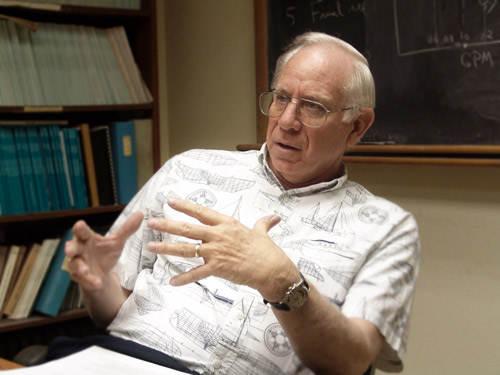
Dr. Phil Schmidt retires from the Mechanical Engineering Department
In the fast-paced high tech world of engineering, the compassionate, people-oriented person isn't always easy to find. Dr. Phil Schmidt, retiring after 42 years as a professor in the Mechanical Engineering Department at The University of Texas at Austin, is that rare combination of scientist, friend and mentor who lives to teach, and has managed to stay true to himself as he navigated the complex system that is higher education. Throughout his long and successful career, he made decision after decision that went against the grain, that wasn't necessarily the expected or popular choice. These choices sometimes cost him sleepless nights, but he consistently let his instincts guide him down his personal life path. His decisions were not about money or power, but about following his passion for teaching. This is evident from the first decision to start his career at an unaccredited minority university in 1968.
Becoming the "They's"
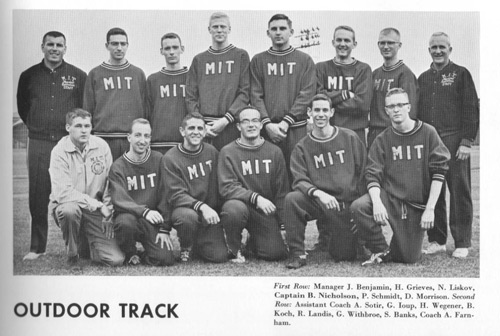
Phil Schmidt in the track team at MIT, where he lettered as a hurdler. He is in the first row, second from right.
After receiving his B.S. in Aeronautics and Astronautics at MIT in 1962, which he described as "trying to drink out of a fire hydrant," Phil worked as an aerodynamicist for Bell Helicopter Company in Ft. Worth. He loved the mix of hands-on experimental and theoretical work involved in helicopter design, but after two years, decided to broaden his professional horizons and headed for Stanford, where he received his M.S. in 1965 and Ph.D. in 1968, both in mechanical engineering.
Phil was in college during some of the most tumultuous days in American history. 1968 was the year that Robert Kennedy and Martin Luther King Jr. were assassinated, and protests against the Vietnam war were igniting the nation. President Johnson had signed into law the Civil Rights Act of 1964, which mandated equal opportunity for minorities, including provisions for education, but progress in implementing these provisions was slow in coming.
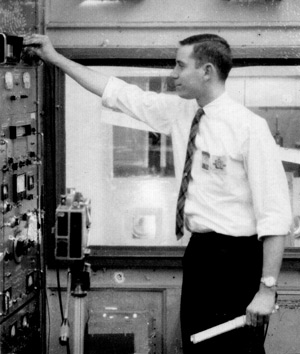
Phil Schmidt during a wind tunnel test at Bell Helicopter Co. in 1963.
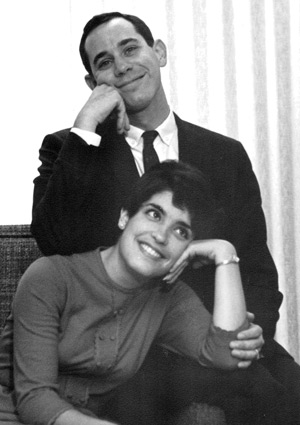
Phil and Donna at their engagement in 1966.
While at Stanford, Phil met a UC Berkeley nutrition major named Donna Packer, and they married while he was still in graduate school. One evening they were at a block party with several Stanford faculty members and heard much discussion about what "they" should be doing about the chaotic state of the nation. The party-goers weren't talking about themselves, comfortable in their elite teaching and research positions, but the unnamed "theys" of the world — the politicians, the social activists, the people who were trying to make a difference by ending the Vietnam war, and fighting for civil rights. Phil and Donna decided that night that they needed to join the "theys."
Against the advice of several of his faculty mentors, he applied for an appointment as a Woodrow Wilson Teaching Intern to teach at Prairie View A&M College, about 50 miles west of Houston. This program, sponsored by the Woodrow Wilson Foundation, provided partial support for new Ph.D.'s from Tier I universities to help alleviate chronic faculty shortages at predominantly black colleges. Prairie View was one of only three such schools with an engineering program. Phil would be one-third of the mechanical engineering faculty, the only white professor in the department, and would teach a dozen different courses over the next two years. Research, of course, was out of the question.
Prior to accepting the Prairie View position, Phil had had an interview at The University of Texas at Austin, and John McKetta, Dean of the College of Engineering at the time, was supportive of his desire to begin his academic career with a post-doctoral public service stint. McKetta told him that an offer to join the University's Mechanical Engineering faculty would be held open for two years while he fulfilled his commitment to Prairie View, and furthermore pledged to be of help if Phil needed anything at Prairie View during the interim.
When he arrived at Prairie View, Schmidt found that none of the equipment in the Mechanical Engineering teaching labs was in working condition and there was no technician to repair it. There was also no access to computers for students. The administration was anxious to get the department accredited through the Accreditation Board for Engineering and Technology (ABET), but that wasn't possible under the given conditions. Schmidt called Dean McKetta and asked for assistance. For the next year, the Chemical Engineering Department sent a technician with a pick-up truck to Prairie View every week to pick up equipment, repair it, and deliver it back. To work around the computer problem, Schmidt contacted the woman in charge of the one computer on campus, housed in the administrative offices of the university, and arranged for his students to use it at night. He resurrected the lab courses and taught computer programming after hours. In 1970, Prairie View's Mechanical Engineering program received its first ABET accreditation. Phil cites his Prairie View department head, Joe Phillips, as an important early mentor, teaching him not only a great deal about how to teach, but how to navigate (and sometimes circumvent) the institutional bureaucracy to get things done.
The Mechanical Engineering Department, Phase I, 1970-1978
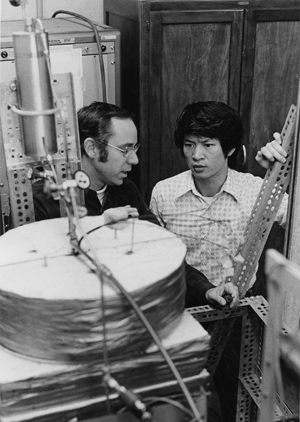
Phil Schmidt discussing a heat transfer experiment with a student in the 1970s.
Schmidt arrived at Mechanical Engineering in 1970 as an assistant professor. He was greatly attracted by the strong team spirit and camaraderie among the professors and staff in the department and the college. The department seemed much like a "family," where everyone cared about everyone else both professionally and personally. He became fast friends with colleagues in and outside the department and established research and teaching collaborations with members of the civil and electrical engineering departments as well as his colleagues in Mechanical Engineering. Undergraduate education was a top priority at The University of Texas at Austin, on a par with contributions to research and graduate studies. This balanced mix of institutional priorities resonated with him and aligned perfectly with his own.
Teaching was always the favorite aspect of his job. He relishes the successes of his former students and loves nothing more than hearing from them years later recounting their recollections of how his teaching had influenced their lives and careers. During the next 30 years, he would go on to build a successful research program, and true to form, his favorite part was the opportunity to work one-on-one with his graduate students. His least favorite part was the incessant quest for funding. He is grateful to early mentors, Parker Lamb, who served as chair from 1970-76, and Grady Rylander, Jr.(PDF [163 Kb] for more details), chair from 1976 to 1986, for their advice in starting his research program and support of his early undergraduate education initiatives. He also remembers Professor Harry Kent (PDF [12Kb]) as an exemplary teacher and respected mentor of students.
Those early years at The University of Texas at Austin, he describes as a "bit of a struggle," trying to juggle the diverse elements of research and teaching to achieve promotion to tenure, while building the Equal Opportunity in Engineering (EOE) Program, which he founded in 1970 in partnership with chemical engineering professor Tom Edgar, at the behest of Dean Earnest Gloyna. The Equal Opportunity in Engineering (EOE) program was a labor of love, rooted in his Prairie View experience, but a huge time sink as well. During the six-year period that he directed the program prior to hiring of a full-time director, hundreds of thousands of dollars in minority scholarships were raised (primarily from corporations), the Pi Sigma Pi minority academic society was formed, and the Minority Introduction to Engineering (MITE) summer program for high school students was initiated. All of these efforts have thrived and are still active today.
In 1978, two years after promotion to Associate Professor, Phil added another job to an already overloaded schedule, a half-time appointment as Associate Dean of the Graduate School. Each week, he spent every afternoon in the Main Building, but his teaching and research roles were not diminished, which, as he remembers it, amounted to having one and a half jobs. Many people in similar positions eventually leave to accept higher administrative appointments somewhere else. Opportunities arose, but Schmidt loved The University of Texas at Austin and preferred to stay on as a professor.
Sabbatical in Industry and building the Process Energetics Program
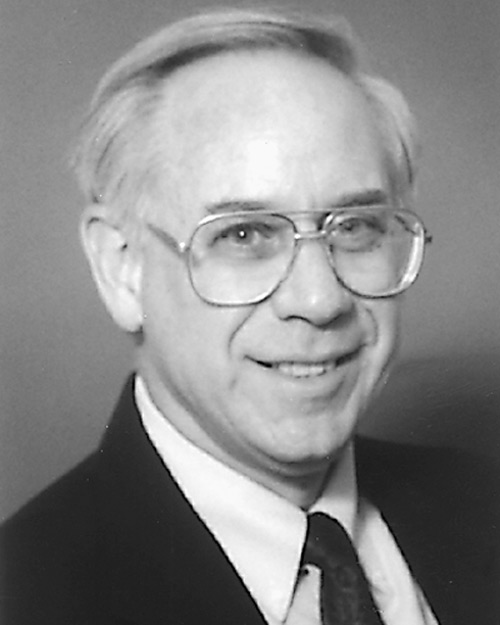
An earlier portrait of Phil Schmidt
Following his stint as an associate dean, Dr. Schmidt took a 15-month sabbatical leave in 1981-82, heading back to Palo Alto to work with the Electric Power Research Institute (EPRI). At EPRI he helped create a new research program in energy-efficient industrial electrotechnologies, such as microwave and high temperature plasma heating (the subject of his Ph.D. research at Stanford). During this time, he wrote a book on the subject and came up with new ideas for his research program at UT. Again, he had offers to leave academia and go into industry, but he missed The University of Texas at Austin and returned to the Mechanical Engineering Department in 1982. After his return and promotion to full professor, he established the interdisciplinary Process Energetics Program in the Center for Energy and Environmental Resources (CEER), working with Professors John Pearce and John Davis in Electrical Engineering and John Howell and Melba Crawford in Mechanical Engineering. He was PI or Co-PI on 12 federal and state research grants totaling over $4 million, and 19 industrial research grants totaling over $2.1 million, supervised 40 master's students and five Ph.D. students, and until 2003 directed the program with the assistance of former grad student Vincent Torres, who now is Associate Director of CEER.
During this same period, Phil collaborated with Mechanical Engineering colleagues Jack Howell and Ofodike Ezekoye, along with then graduate student Derek Baker, to develop a series of videotapes and subsequently a large-scale web resource entitled to introduce real-world applications into the teaching of thermodynamics. These projects, with support totaling over $300,000 from the National Science Foundation, enabled the founding of the College of Engineering Instructional Media Lab, now the Faculty Innovation Center. continues to be used by engineering students around the world.
The Mechanical Engineering Department Phase II
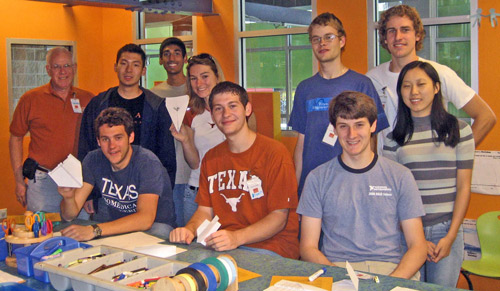
Schmidt at the Children's Museum
After 30 years as a teaching and research professor, Schmidt, again acting contrary to conventional wisdom and the advice of colleagues, made another unusual career decision: he decided to wind down his research efforts and concentrate the remainder of his career where his true passion lay, in teaching, and especially undergraduate teaching.
From 2000 to 2010, when he began phased retirement, he served the department as Associate Chair for Undergraduate Program Development, leading the ME faculty in developing one of the premiere undergraduate engineering education programs in the country, PROCEED, an acronym for Project-Centered Education. The program integrates theory with hands-on learning throughout the curriculum. Engineering fundamentals are difficult to master, and students are motivated by studying theory in the context of real-world engineering projects. Schmidt worked closely with Mary Beth Maddox in the Cockrell School of Engineering Development Office to obtain over $1.25 million in funding for development of teaching labs and curriculum resources. PROCEED was recently cited by the National Academy of Engineering as one of the exemplary programs in the U.S. for integrating real-world experience into engineering education. Dr. Schmidt has received a number of awards for this effort, including the Regent's Outstanding Teaching Award, the Chancellor's Council Outstanding Teaching Award, and the American Society for Engineering Education's Chester Carlson Award, the society's highest award for innovation in engineering education.
Throughout his career Schmidt received numerous awards as an exceptional classroom teacher. Most notable were his naming, in 1994, as Texas Professor of the Year by the Carnegie Foundation for the Advancement of Teaching, and his selection, in 1995, as one of the ten inaugural members of the University's Academy of Distinguished Teachers, the first member of the College of Engineering to be so recognized.
Life Values
Schmidt hopes that students will remember him for setting high standards and working hard to help them achieve those standards. He feels that engineering is one of the most rigorous courses of study one can undertake, and any student who has chosen it is special. It's not easy to learn, and he wants even the very brightest students to have to work at it. He strongly believes in the value of failure. He speaks of his own failures, especially failing thermodynamics and having to repeat the course at MIT, that taught him the most and often changed the course of his life in ways he would never have foreseen. He spoke of students coming to him to discuss academic or career-choice dilemmas, often wondering if making one choice over another would jeopardize their opportunities for the future. He believes that we often have to rely on our instincts of what "feels" right, and that once a choice is made, the original concern is history. Rather than dwelling on what might or might not be, it's then time to forge ahead and make that decision work out for the best.
Schmidt embraces challenges and admires risk-taking in others. He cites his wife Donna's, decision to go back to school at age 50 to earn a nursing degree as the type of challenge he's talking about. It was very difficult, as she hadn't studied or worked professionally since their first child was born, and she had to complete two years of undergraduate prerequisites before she could even qualify for the graduate program. But she persisted, eventually earning academic honors, receiving her Master's degree, and going on to a satisfying career as a mother/baby nurse.
Schmidt advises students to trust their instincts and live their lives according to their own plans and values, not those dictated by others. While "toeing the line" may sometimes yield more wealth and power, it does not necessarily lead to the greatest happiness. His definition of the perfect job is one where we look forward to going to work every morning and look forward to coming home every night; he believes his career at the university has, indeed, satisfied this criterion.
Phase III, The Future
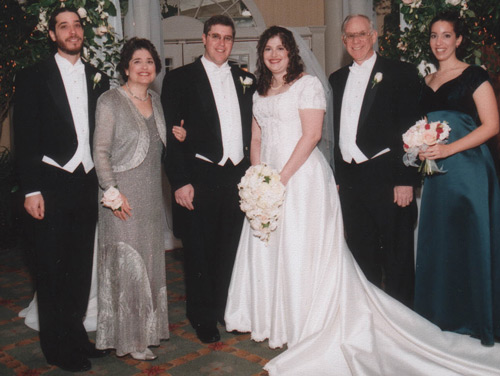
Allan and Shari's Wedding in 2002. From left to right, Danny, Donna, Allan, Shari, Phil and Lauren.
What's next will be time spent with the most important people in his life — family and students. Phil and Donna have three children, sons Allan and Danny, and daughter Lauren. Lauren, husband David, and their children Maya and Jacob live in Denver, so Phil and Donna now have a condo there and will play the part of doting grandparents Colorado-style several months a year. Allan and his wife Shari are in Plano with daughter Mira, therefore frequent trips up I-35 are in the works. And singer/songwriter Danny will marry his lovely fiancé Carrie Elkin, also a performing artist, in 2014, so wedding bells will be in the air here in Austin. While extensive travel is not their top priority, Donna and Phil are planning a long-deferred trip to Israel in 2014, and hope one day to be groupies for one of Danny and Carrie's performance tours in the UK.
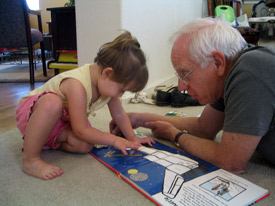
Schmidt showing his granddaughter Maya the "space shovel."
Phil plans to stay connected with the Mechanical Engineering department, continuing to promote excellence in undergraduate education and mentoring student project groups. He'll maintain an office in the ETC building and will remain involved with PROCEED . He expects to expand his efforts in support of K-12 education, mentoring students on science and engineering projects, and continuing to work with the Austin Children's Museum, where he initiated the Engineering Saturdays Program in 2008.
As a person who relishes the surprises and challenges life brings, Phil looks forward to whatever is coming next. We thank him for what he has given all of us and the students of Texas, and we wish him and Donna the best in this next phase of their journey together.
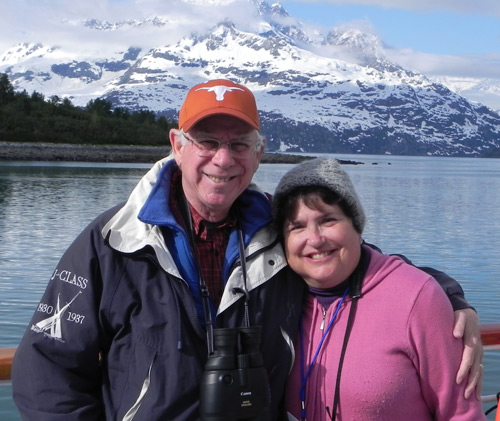
Phil and Donna in Alaska in 2010






